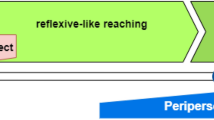Abstract
In this study we show how simulated robots evolved to display a navigation skills can spontaneously develop an internal model and rely on it to complete their task when sensory stimulation is temporarily unavailable. The analysis of some of the best evolved agents indicates that their internal model operates by anticipating functional properties of the next sensory state rather than the exact state that sensors would have assumed. The characteristics of the states that are anticipated and of the sensory-motor rules that determine how the agents react to the experienced states, however, ensure that the agents produce very similar behaviour during normal and blind phases in which sensory stimulation is available or is self-generated by the agent itself, respectively. The characteristics of the agents’ internal models also ensure an effective transition during the phases in which agents’ internal dynamics is decoupled and re-coupled with the sensory-motor flow.
Access this chapter
Tax calculation will be finalised at checkout
Purchases are for personal use only
Preview
Unable to display preview. Download preview PDF.
Similar content being viewed by others
References
Craik, K.: The Nature of Explanation. Cambridge University Press, Cambridge (1943)
Tolman, E.C.: Cognitive maps in rats and men. Psychological Review 55, 189–208 (1948)
Johnson-Laird, P.: Mental Models: Towards a Cognitive Science of Language, Inference, and Consciousness. Cambridge University Press/Harvard University Press, Cambridge (1983)
Brooks, R.A.: Intelligence without representation. Artificial Intelligence 47(47), 139–159 (1991)
Kawato, M.: Internal models for motor control and trajectory planning. Current Opinion in Neurobiology 9, 718–727 (1999)
Wolpert, D.M., Gharamani, Z., Jordan, M.: An internal model for sensorimotor integration. Science 269, 1179–1182 (1995)
Clark, A., Grush, R.: Towards a cognitive robotics. Adaptive Behavior 7(1), 5–16 (1999)
Frith, C.: Making up the Mind. In: How the Brain Creates our Mental World. Blackwell, Malden (2007)
Grush, R.: The emulation theory of representation: motor control, imagery, and perception. Behavioral and Brain Sciences 27(3), 377–396 (2004)
Jeannerod, M.: Neural simulation of action: A unifying mechanism for motor cognition. NeuroImage 14, S103–S109 (2001)
Jeannerod, M.: Motor Cognition. Oxford University Press, Oxford (2006)
Pezzulo, G., Castelfranchi, C.: The symbol detachment problem. Cognitive Processing 8(2), 115–131 (2007)
Wolpert, D.M., Doya, K., Kawato, M.: A unifying computational framework for motor control and social interaction. Philos. Trans. R. Soc. Lond. B. Biol. Sci. 358(1431), 593–602 (2003)
Wolpert, D., Miall, C., Kawato, M.: Internal models in the cerebellum. Trends Cogn. Sci. 2, 338–347 (1998)
Lee, D.N., Thompson, J.A.: Vision in action: the control of locomotion. In: Ingle, D.J., Goodale, M.A., Manfield, R.J.W. (eds.) Analysis of Visual Behavior, pp. 411–433. MIT, Cambridge (1982)
Ziemke, T., Jirenhed, D.A., Hesslow, G.: Blind adaptive behavior based on internal simulation of perception. Technical Report HS-IDA-TR-02-001, Department of Computer Science (School of Humanities & Informatics), University of Skovde, Sweden (2002)
Ziemke, T., Jirenhed, D.A., Hesslow, G.: Internal simulation of perception: a minimal neuro-robotic model. Neurocomputing 68, 85–104 (2005)
Alnajjar, F., Hafiz, A.R., Zin, I.B.M., Murase, K.: Vision-motor abstraction toward robot cognition. In: Leung, C., Chan, J. (eds.) ICONIP 2009, Part II. LNCS, vol. 5864, pp. 65–74. Springer, Heidelberg (2009)
Johnsson, M., Balkenius, C., Hesslow, G.: Neural network architecture for crossmodal activation and perceptual sequences. Papers from the AAAI Fall Symposium (Biologically Inspired Cognitive Architectures), Arlington, Virginia, USA, pp. 85–86 (2009)
Linker, F., Niklasson, L.: Extraction and inversion of abstract sensory flow representations. In: Proceedings of the Sixth international Conference on Simulation of Adaptive Behavior, From Animals to Animates, vol. 6, pp. 199–208. MIT Press, Cambridge (2000)
Manoonpong, P., Wrgtter, F.: Efference copies in neural control of dynamic biped walking. Robotics and Autonomous Systems 57, 1140–1153 (2009)
Pezzulo, G.: A study of off-line uses of anticipation. In: Asada, M., Tani, J., Hallam, J., Meyer, J.A. (eds.) SAB 2008. LNCS (LNAI), vol. 5040, pp. 372–382. Springer, Heidelberg (2008)
Svensson, H., Morse, A., Ziemke, T.: Representation as internal simulation: A minimalistic robotic model. In: COGSCI (2009)
Gigliotta, O., Nolfi, S.: On the coupling between agent internal and agent/ environmental dynamics: Development of spatial representations in evolving autonomous robots. Adaptive Behavior 16(2-3), 148–165 (2008)
Nolfi, S., Floreano, D.: Evolutionary Robotics. MIT Press, Cambridge (2000)
Hesslow, G.: Conscious thought as simulation of behaviour and perception. Trends in Cognitive Sciences 6, 242–247 (2002)
Author information
Authors and Affiliations
Editor information
Editors and Affiliations
Rights and permissions
Copyright information
© 2010 Springer-Verlag Berlin Heidelberg
About this paper
Cite this paper
Gigliotta, O., Pezzulo, G., Nolfi, S. (2010). Emergence of an Internal Model in Evolving Robots Subjected to Sensory Deprivation. In: Doncieux, S., Girard, B., Guillot, A., Hallam, J., Meyer, JA., Mouret, JB. (eds) From Animals to Animats 11. SAB 2010. Lecture Notes in Computer Science(), vol 6226. Springer, Berlin, Heidelberg. https://doi.org/10.1007/978-3-642-15193-4_54
Download citation
DOI: https://doi.org/10.1007/978-3-642-15193-4_54
Publisher Name: Springer, Berlin, Heidelberg
Print ISBN: 978-3-642-15192-7
Online ISBN: 978-3-642-15193-4
eBook Packages: Computer ScienceComputer Science (R0)




